IoT in 2024: A Look Back and Forward with Kaa IoT
January 17, 2024The landscape of the Internet of Things (IoT) in 2024 is both a reflection and projection of the transformative journey it has undertaken. In the previous year, the proliferation of connected devices reached a staggering 15.14 million globally, with an anticipation to nearly double by 2030.
The economic forces driving this surge are remarkable, with the global IoT market projected to escalate from $662.21 billion in 2023 to an astonishing $3,352.97 billion by the end of this decade. This article delves into the significant strides made across diverse industries, from healthcare and manufacturing to smart cities, as we navigate through the past, present, and future of IoT.
IoT in 2023: Recap
Nowadays, there are 15.14 million connected IoT devices worldwide. And the number is expected to almost double by 2030.
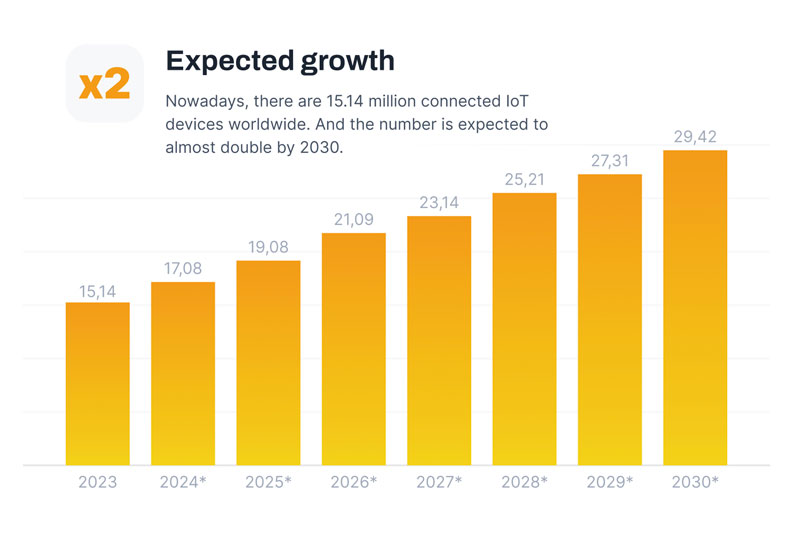 Sources: Statista, Fortune Business Insights
Sources: Statista, Fortune Business Insights
The global IoT market is projected to grow from $662.21 billion in 2023 to $3,352.97 billion by 2030, at a CAGR (Compound Annual Growth Rate) of 26.1% from 2023 to 2030.
Industries
Major industry verticals have over 100 million connected IoT devices:
- Agriculture
- Banking, financial services and insurance (BFSI)
- Healthcare
- Government
- Retail and wholesale
- Manufacturing
- Sustainable energy
- Transportation and storage
- IT and telecom
Healthcare and manufacturing are projected to have the highest market share during 2023-2030 (Sources: Fortune Business Insights).
Artificial intelligence in IoT
The global AI in IoT market is projected to reach $91.7 billion by 2032, growing at a CAGR of 24.8% from 2023 to 2032, with the service segment expected to show the highest growth (source: Allied Market Research).
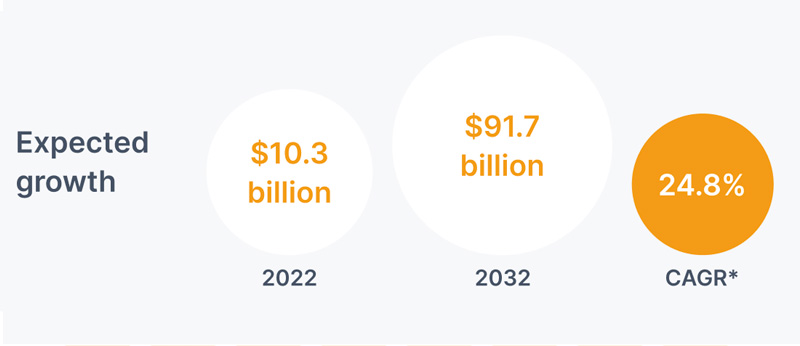 Source: Allied Market Research
Source: Allied Market Research
* - CAGR (Compound Annual Growth Rate)
The expansion of AI in IoT applications will provide lucrative growth opportunities for the market in the upcoming years, especially for the industries displayed above.
Industrial IoT
The industrial IoT market segment is expected to hit around USD 1,562.35 billion by 2032, with a CAGR of 17.2% during the forecast period of 2023–2032.
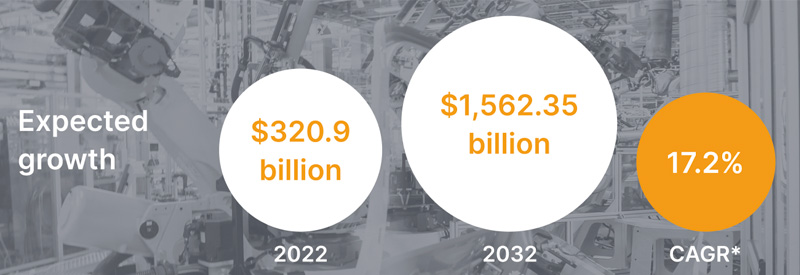 Source: Precedence Research
Source: Precedence Research* - CAGR (Compound Annual Growth Rate)
The most popular applications of IIoT are as follows:
- Remote monitoring
- Data management
- Analytics
- Security solutions
The main use cases for IIoT include the following:
- Manufacturing
- Energy and power
- Oil gas
- Healthcare
- Logistics transport
- Agriculture
Healthcare IoT
The global IoT in healthcare market is anticipated to increase from $127.7 billion in 2023 to $289.2 billion by 2028, at a CAGR of 17.8%, with the telemedicine segment expected to hold the highest market share.
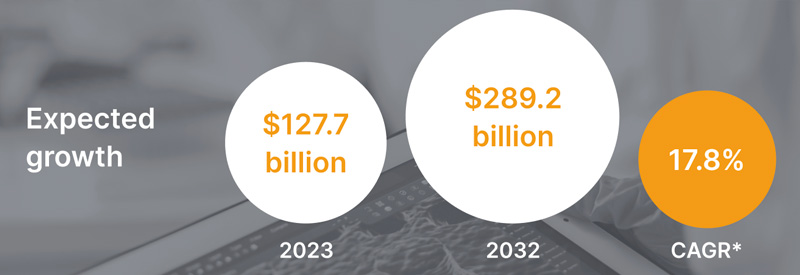 Sources: Quectel, MarketsandMarkets
Sources: Quectel, MarketsandMarkets* - CAGR (Compound Annual Growth Rate)
IoT in healthcare is capable of reducing costs incurred by operational and clinical inefficiencies by $100 billion per year.
IoT solutions can bring vast improvements to the following use cases:
- Drug administration
- Disease management
- Diagnosis accuracy
- Condition monitoring
- Health data management
- Patient experience
Automotive IoT
The global automotive IoT market in terms of revenue was estimated to be $131.2 billion in 2023 and is poised to reach $322.0 billion by 2028, growing at a CAGR of 19.7% from 2023 to 2028.
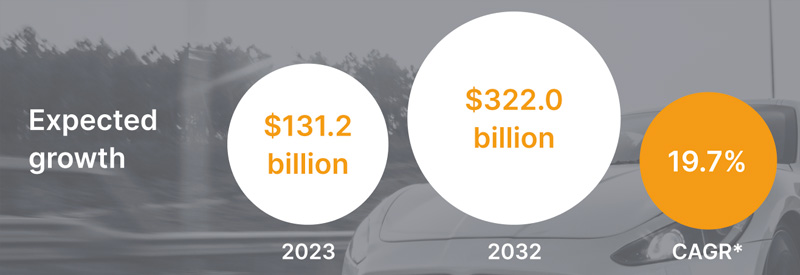 Source: MarketsandMarkets
Source: MarketsandMarkets* - CAGR (Compound Annual Growth Rate)
In-vehicle communication will hold a significant automotive IoT market share during 2023–2028.
The main automotive IoT applications are the following:
- Navigation
- Telematics
- Infotainment
Agriculture IoT
The global IoT in agriculture market was valued at $13.61 billion in 2022 and is projected to be worth around $33.57 billion by 2032, with a registered CAGR of 9.50% from 2023 to 2032.
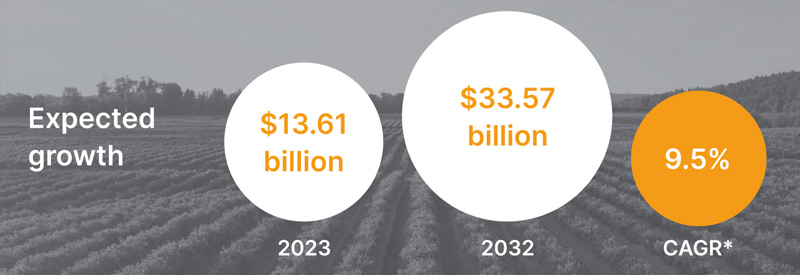 Source: Precedence Research
Source: Precedence Research* - CAGR (Compound Annual Growth Rate)
The following main factors contribute to the growth of the agriculture IoT market:
- Increasing adoption of the IoT and AI by farmers
- Growing focus on livestock monitoring and disease detection
- High demand for fresh produce
- Population growth
- Loss of arable land
- Strong government support for precision farming
IoT is implemented in various applications, including:
- Precision farming
- Livestock monitoring
- Precision aquaculture
- Smart greenhouse
Smart cities
The global IoT in smart cities market was valued at $148.6 billion in 2022 and is projected to reach $931.5 billion by 2032, growing at a CAGR of 20.5% from 2023 to 2032.
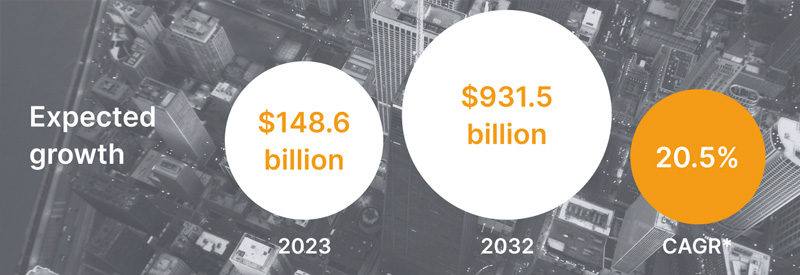 Source: Allied Market Research
Source: Allied Market Research* - CAGR (Compound Annual Growth Rate)
The key applications of smart cities include the following:
- Smart transportation
- Smart building
- Smart utilities
- Smart citizen services (education, healthcare, public safety, etc.)
The following are the primary factors driving the growth of IoT in the smart city market:
- Growth in deployment of connected and smart technologies
- Increase in government initiatives and smart city projects
- Sustainability and resource optimization
The future of IoT
- The trajectory of IoT points towards a future where connected devices become ubiquitous, driving unprecedented efficiency and convenience, especially for the specified industries:
- Manufacturing
- Healthcare
- Smart cities
- Advancements in technology will help the IoT reach new heights, making it possible to process data seamlessly and make decisions in real time:
- Edge computing
- 5G connectivity
- AI algorithms
- The future of the IoT hinges on responsible development. The IoT has the potential to revolutionize our world, but only if we do the following:
- Build responsibly
- Collaborate
- Put ethical concerns first
- Challenges:
- Ensuring data privacy and ethical practices requires cybersecurity to be a top priority.
- Standardization across platforms is absolutely necessary in order to avoid the fragmentation of the ecosystem.
- Data sovereignty is also an important issue that must be taken seriously.
- The success of overcoming the challenges will be very important for the future of the IoT. It promises to bring about a world where increased productivity goes hand in hand with sustainability and an improved quality of life.
Conclusion
As we gaze into the future of IoT, the trajectory is undeniably promising. The fusion of IoT with artificial intelligence is set to propel the market to unprecedented heights. Industries such as healthcare, agriculture, automotive, and smart cities are experiencing profound transformations, redefining the way we live and work.
However, this journey is not without its challenges. The imperative to build responsibly, collaborate, and prioritize ethical considerations is crucial for sustained growth. Overcoming challenges related to data privacy, cybersecurity, standardization, and data sovereignty will be pivotal in realizing the true potential of IoT. Yet, the vision is clear: a world where increased productivity coexists with sustainability and an elevated quality of life.
